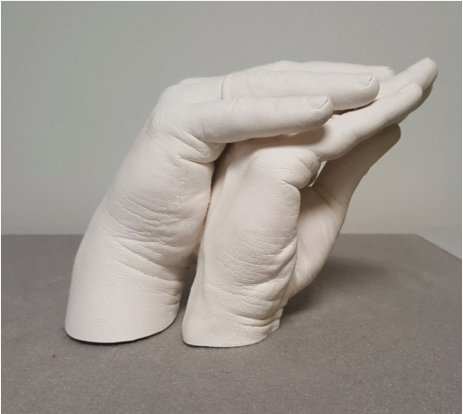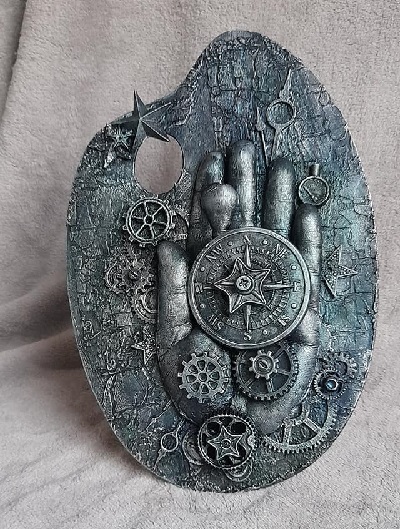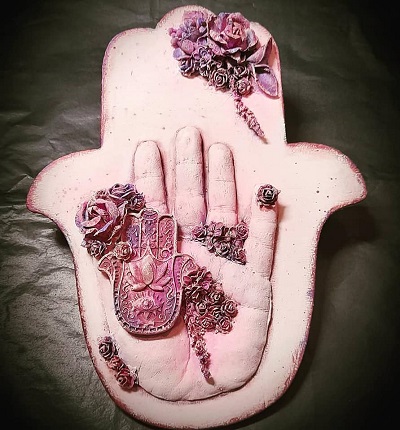Body afdruk maken in Alginate en gegoten met A1
A1Creatives in combinatie met Cavex Clever Cast Alginate zijn perfect geschikt voor het maken van gedetailleerde en levensechte afdrukken van lichaamsdelen zoals je handen of voeten.
Op deze pagina geven we je een korte beschrijving om zelf je eerste handafdruk te maken.
Alle hier gebruikte foto’s zijn afdrukken gemaakt door niet professionele Bodycasters. Op zoek naar een perfecte afdruk van een dierbare of een uniek moment neem dan contact op met een professionele Bodycaster.

Mixed Media Body Casting projects
Preparation for making the Bodycasting
Make sure you have ready:
- A1 Liquid
- A1 Powder
- (Cavex Clever Cast) Alginate
- Plastic bucket for preparing Alginate
- Plastic cup for mixing A1
- Sanding sponge
- Stirring sticks
- Wooden stick
The list on the left contains everything you need for work. However, if you have kitchen scales, they can come in handy if you choose to divide the set into several, smaller castings.
Plan the grip position so that when placing both hands in the bucket, no part of the hand touches the walls or bottom of the bucket, the desired distance.
Step 1. Mould making
- Mix Cavex alginate with water (~1-2 min);
- Place your hands in the desired position;
- Hold hands until alginate is set (~5 min)
Pour 1.5 kg of water into the bucket (up to the mark on the bucket), while stirring add CAVEX CLEVER CAST alginate powder. Continue to stir vigorously until smooth consistency for 60-120 seconds, small grains are normal.
Use cold tap water (do not use warm water), you must act quickly from the moment the powder is added.
Immediately place your hands in the desired position in the mixed mass (if necessary, first pour alginate into another container according to the size).
Alginate will start to harden in about 3-5 minutes. In the meantime, keep your hands in the prescribed position without removing your hands until the mass has hardened. It can be checked with your free hand, when the mass has become firm and no longer sticky, you can carefully pull out your hands.
Check that no alginate particles have fallen into the mould.
You can immediately mix A1 (Acrylic One) and pour it into the resulting form. The alginate form dries quickly, if for some reason it is not possible to pour immediately, then cover the alginate with a damp paper towel and place in the refrigerator without delaying casting for more than 24 hours.
If you choose to make a smaller impression, then find a suitable container and measure the required amount. Mixing ratio 3 parts water: 1 part alginate. It is most convenient to measure by pouring water into a container, then weigh or calculate the volume and adjust the required amount of alginate accordingly.
Table for indication:
WATER CAVEX CLEVER CAST alginate
200 g 67 g
450 g 150 g
1000 g 334 g
Cavex CleverCast is very user-friendly, thanks to its convenient mixing in a flexible ratio (water: alginate powder), it can also be used to make a mould from other object. For small prints: 1: 1 or 1: 2, For larger prints: 1: 3 or 1: 4. Curing time 3-5 minutes.
Attention! Alginate will be difficult to remove from clothing, choose appropriate clothing or fold up sleeves. However, if the alginate gets on your clothes, allow it to dry thoroughly, clean as much as possible with a brush, and then wash in warm water.
Step 2. Casting of A1 in the Alginate Mould
- Mix A1 material components for impression casting (~1 min);
- Pour into the resulting form;
- Let it set (~ 1h).
Weigh 1 part of A1 liquid and 2 parts of A1 powder. Stir for 30-60 seconds until smooth. Pour about 1/3 in the alginate mould, rotate and vibrate so that the mass enters all the fingertips, then fill with the remaining mass. When the mould is full, vibrate again by gently tapping the edges of the bucket, this will help the air bubbles to rise. Leave the mass too harden for about 1hour.
Step 3. Demoulding and Processing
- Remove from the bucket;
- Carefully release the casting from the alginate parts;
- If necessary, fill the air pockets and sand the base.
Carefully turn the bucket to the other side, pressing the bottom of the bucket will easily release the alginate mass from the walls and slip out.
The alginate mass can be carefully removed in pieces from the hand cast, if necessary by lightly cutting with a knife. Be careful not to cut into the casting and where it may be more fragile, such as nails, free-standing fingers.
If there are air pockets and bubbles left that you want to fill, mix the A1 liquid and A1 powder that was left and fill in the appropriate places, a wooden stick can be used.
Use sandpaper to level the base and smooth imperfections if any. Allow the casting to dry completely in a dry and warm place.
If you wish, you can paint, decorate, varnish the casting and attach it to a wooden or other base.








